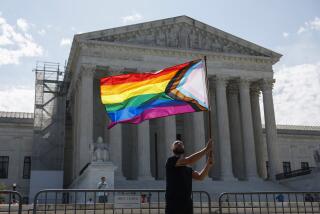Unwed Partners Up 72% in U.S.
- Share via
Like divorce and single parenthood in earlier times, cohabitation spilled out of big cities and university towns in the 1990s and has become part of life even in the nation’s most conservative regions, U.S. census data show.
The number of unmarried-partner households rose 31% in the ‘90s in Los Angeles County, the birthplace of palimony, but shot up 72% nationwide. The largest gains came in the Bible Belt and across the Great Plains.
Even in seven states where laws against cohabitation remain on the books, living together almost doubled over the decade of the ‘90s, according to the 2000 census data.
“I don’t see us formalizing,” said Chris Sheets, who lives with her partner, John May, in the North Carolina Outer Banks hamlet of Kill Devil Hills. North Carolina is one of the states that still outlaws cohabitation. “Neither of us is religious and we need no wedding presents to further clutter our house.”
So widespread has cohabitation become that some rural counties in Wyoming and Minnesota now have the same ratio of unmarried-partner households as do more urban counties in New York and California.
Within California, cohabitating couples are about as common in towns with populations of 5,000 or less as in cities of 100,000 or more.
“The tolerance is not just in the elite areas,” said Stephanie Coontz, co-chairwoman of the Council on Contemporary Families. “Cultural acceptance and science have broken the old tight equation of marriage and child-rearing. All forms of families are claiming legitimacy and, to some extent, are getting it.”
Social scientists continue to debate whether the increase in cohabitation further undermines the stability of the traditional American family. Some studies have shown that cohabitation serves as a valuable premarital compatibility test, while others have found that couples who live together before marrying are more likely to get divorced.
But for good or ill, the trend seems firmly established. Government policies have changed to accommodate live-in relationships and those changes, in turn, have institutionalized them in both law and language.
Live-in lovers in the age of AIDS metamorphosed into domestic partners, removing much of the stigma of such relationships and fighting for health care and workplace rights.
“Just the term ‘unmarried partner’ gave it a dignity and social category,” said Paula Ettelbrick, family policy director of the National Gay & Lesbian Task Force.
Pressured by courts and constituents, cities and states created registries of unmarried couples during the 1990s, giving them rights that were the same--or similar to--those granted to spouses on hospital visitations, access to children’s school records and a variety of government benefits.
A number of prominent companies redefined their benefits policies to include partners, as did some insurers, credit unions, health clubs and airlines--concessions fought for and won mostly by gay groups, but enjoyed as well by the much larger population of heterosexual unmarried couples.
In California, opposite-sex couples constitute about 86% of unmarried-partner households.
For most people, cohabitation remains a transitory phase on the way to marriage or breakup. University of Wisconsin researchers have found that about 50% of couples now live together before a first marriage, up from just 10% a generation ago, and about two-thirds do so before a second marriage.
But about 95% of such couples marry or end their relationship within five years.
Alternative to Marriage for Some
“It’s a test run,” said Kit Russell of Goleta, who expects to wed her live-in partner and is convinced that the experience saved her from a disastrous marriage to a previous boyfriend.
Still, researchers say the 2000 census also captured a burgeoning group of unmarried partners who see cohabitation as an alternative to marriage, not a precursor.
Made wary by their parents’ divorces or their own missteps, long-term cohabitants look for individualistic arrangements that exist outside what their state, religion or relatives dictate, said Scott Coltrane, a sociology professor at UC Riverside.
“When couples get married, there are expectations about gender roles, about having children, about settling down,” said Sidelia Reyna, who lives with Todd Bennett, her partner of more than five years, in Oxford, Ohio. “It makes more sense for couples to figure out their own rules.”
For same-sex couples, three forces came together in the ‘90s that served to persuade partners to live more openly, even in places formerly thought of as hostile territory.
AIDS activism, the fight for domestic-partner status and an emerging movement that espoused legalizing gay marriages combined to make same-sex couples more visible than ever and more comfortable with being so, said Kim Mills, education director for the Human Rights Campaign.
In 1990, less than half the nation’s counties reported any same-sex, unmarried-partner households. In 2000, almost all reported some.
Although San Francisco predictably led the list of metropolitan areas with the highest percentage of households made up of same-sex partners, Portland, Maine; Burlington, Vt.; Asheville, N.C.; and Springfield, Mass., all ranked in the top 15 in that category--ahead of New York and Los Angeles.
“We still run into politicians who say, ‘I don’t have any gay constituents,’ ” Mills said. “Once we get these [census] numbers, we can say, ‘Yes, you do.’ ”
Though the new data indicate Americans’ comfort with cohabitation deepened in the last decade, it lags well behind that of Western Europeans and Canadians, who have embraced and codified such relationships for decades. The U.S. Census Bureau’s unmarried-partner category dates back only to 1990.
Even in middle age, many U.S. cohabitants confess they still struggle to reconcile their lifestyle with their parents’ wishes.
In North Carolina, Sheets says her father has repeatedly told her he wants to see her married before he dies. “That’s a bit of pressure, for sure,” she said.
Younger couples get little guff; many of their parents have cohabited too.
“They didn’t have the right to give me attitude,” said James Olson, 28, who has lived with his girlfriend in South Pasadena for about six months.
On a societal scale, the backlash against increased cohabitation may take forms that go beyond parental disapproval.
Those who see the census figures as further evidence of the erosion of the traditional family are pushing for changes in the tax code and other federal programs to promote traditional unions.
Studies show that an increasing number of unmarried-partner households also include children. If these relationships are less stable than marriages, children will experience more flux as well, said Pamela Smock, a sociology professor at the University of Michigan.
Long-term unmarried couples, however, say their relationships are every bit as permanent as those cemented with wedding vows.
Shannon, a woman who lives in Burbank with her partner of six years but asked that her last name not be used, said the marriage ritual itself held little meaning for her.
“Other than dressing up in a beautiful dress and having one day that is totally about me, I have no real desire to be married,” she said. “Which is not to say that I don’t want a committed relationship. I do, and that is what I have.”
(BEGIN TEXT OF INFOBOX / INFOGRAPHIC)
Living Together
The 1990s brought a significant increase in both opposite-sex and same-sex unmarried partner households in even the most conservative regions of the country, according to new census data.
*
Number of unmarried partner households:
*--*
2000 1990 Change U.S. 5,475,768 3,187,772 72% California 683,516 495,223 38%
*--*
*
The states with the greatest percentage of households made up of unmarried partners in 2000:
*
*--*
% households, State unmarried partners Maine 3.0 Vermont 3.0 Nevada 2.7 Alaska 2.6 Washington, D.C. 2.6 New Hampshire 2.6 Oregon 2.5 New Mexico 2.4 Washington 2.4 Arizona 2.3 Delaware 2.3 Florida 2.3 California 2.0 United States 1.9
*--*
*
Metropolitan areas with the greatest percentage of same-sex unmarried partner households:
*
*--*
% households, Metropolitan area same-sex partners San Francisco- Oakland-San Jose 1.13 Santa Fe, N.M. 1.07 Portland, Maine .91 Burlington, Vt. .85 Miami-Ft. Lauderdale .83 Albuquerque .79 Atlanta .79 San Diego .77 Asheville, N.C. .77 New York .74 Los Angeles-Riverside -Orange Counties .73
*--*
*
NOTE: Does not include metropolitan areas in Alaska, Mississippi or Texas
Sources: U.S. Census Bureau; Urban Institute
More to Read
Sign up for Essential California
The most important California stories and recommendations in your inbox every morning.
You may occasionally receive promotional content from the Los Angeles Times.













